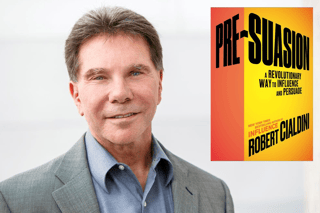Growth Insights for CEOs
Tom McCrary
/CMO-Tom-McCrary.jpg?width=320&name=CMO-Tom-McCrary.jpg)
Recent Posts

Outsider Insights | From Hustle to System: Why More CEOs Are Rebuilding Their Sales Function
Outsider Insights
Across Chief Outsiders, we talk to hundreds of CEOs every month. In this new series, we explore the trends and challenges we’re hearing from these discussions – and what you can do if you’re facing the same issues in your business.
Recent Posts

A Conversation with Robert Cialdini, Author of "Pre-Suasion, A Revolutionary Way To Influence And Persuade"
Tue, Apr 4, 2017 — At our recent National Meeting, Chief Outsiders hosted a dynamic Skype conversation with Dr. Robert Cialdini on his latest book Pre-Suasion, A Revolutionary Way To Influence And Persuade. The discussion not only further clarified not only Cialdini’s Pre-Suasion principles, but also provided insight into their applications to our clients’ and our specific business as well.

How to Leverage Visioning to Drive Value
Tue, Aug 11, 2015 — There was a recent exchange on Twitter between Tom Peters and others debating Vision vs. Excellence. Rather than thinking about this as an either/or proposition, a third path – Vision with Excellence – creates the greatest value. As stated in a Japanese proverb – “Vision without action is a daydream. Action without vision is a nightmare.” Having a clear Vision of the future you want to create, taking the necessary steps to activate it and exhibiting the behaviors needed to make things happen are a powerful formula for driving growth and prosperity for your business. The following are steps that you can take to leverage visioning to drive value in your organization.

Are You Going To "Finish Big"?
Wed, Oct 29, 2014 — I had the opportunity to hear Bo Burlingham speak last year about his upcoming book, Finish Big: How Great Entrepreneurs Exit on Top. Many of you might be familiar with Burlingham from his groundbreaking work, Small Giants—Companies That Choose To Be Great Rather Than Big. In his latest book, he takes an in-depth look into the specific phase in a company’s life when its Owners/CEOs/Partners begin to consider exiting their business. His relevant ideas and sharp insights in this discussion of Finish Big were so compelling to me that I wanted to share highlights with you. I encourage you to get the book when it is released at the end of November 2014 so that the concepts below can come alive for you as well.
Stay up-to-date with the latest from Chief Outsiders

D.A.R.E. to Grow
Wed, Feb 20, 2013 — Sometimes it is difficult for our organizations to take the steps necessary to grow – to change – to leave what is comfortable and strive for something more. We stop ourselves with questions like: How will my organization adapt to the changes? Can we handle the new challenges? Do we have the skills required to meet the new demands? Why should we upset what is already going well? It makes perfect sense for us to question. In fact, we wouldn’t be doing our jobs as leaders if we didn’t. At some point though, if we want to move forward, we must also move beyond the questions. We must take our own dare, if you will – and D.A.R.E. to grow. Here are some thoughts to get us started. D = Discover

The Importance of Authentic Service and Hospitality in Business
Tue, Oct 2, 2012 — What Makes Exceptional Service in Your Business? Recently I have been looking more closely at service — which factors contribute to great service in business and which elevate the quality of service to exceptional levels. I have considered both the objective, measurable components of service as well as the subjective — less tangible factors that focus on the specific relationship between those served and those serving. It's fairly simple for us to evaluate the concrete aspects of service. We, as marketers, preach and follow mantras of "what gets measured, gets done," and "if we can't measure it, we can't manage it." We rate and measure service quality with customer satisfaction research and Net Promoter scores. Measurement is, and will continue to be, a critical component of our understanding and responding to day-to-day performance in our businesses. In today's increasingly competitive market though, is evaluating only the easily measured variables sufficient? Is doing this alone enough to raise our customer service from great to exceptional? Does it ensure that our business performance is consistent with our vision, values and strategy?

3 Top Sources of Strategic Marketing Insights
Mon, Jul 18, 2011 — Effective marketing strategies that drive significant results are almost always based on key insights. Insights can come from a lot of different places – from research, from a review of operations, from an analysis of the market, from a review of available data, from experience. The critical common element to game-changing insights is perspective – looking at the situation from a customer/prospect/market point of view. Let’s look at some examples: 1. Research-based Insight At Northeast Savings, we conducted a major customer segmentation study to better understand the needs of our consumers. One of the key findings of the research was a hierarchy of concerns expressed by a key constituency – 50+ consumers. Their number one issue was their health; followed closely by their financial well being, especially as it related to being able to take care of themselves should anything happen to them physically. This insight, coupled with an understanding of the need for conservative investments (in this case, CDs) due to the risk profile of older people, led to the creation of the “Take Ten” CD. This was a traditional CD, earning market interest rates, with a twist – you could withdraw up to 10% of your principal without penalty. Northeast Savings was the first bank in the country to offer this type of CD and was recognized in USA Today. More importantly, the CD garnered $180M in new deposits in the first three months and, after a year, no one had exercised the option to withdraw principal. Consumers wanted the security of knowing that they could, but really needed to earn interest on their deposits.
.png?width=1500&height=398&name=CO_Corporate%20Logo%202021_4C_HOR_FNL-1%20(1).png)